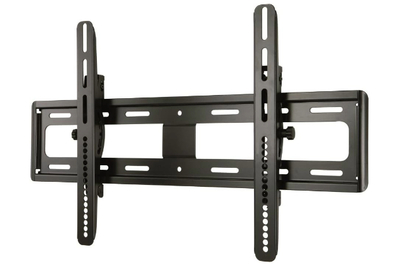The 4 Best TV Wall Mounts of 2025

Top pick
Important specs
| Type of mount: | Tilt | # of VESA patterns: | 22 |
| Degree of tilt: | 9° / -10° | Maximum weight limit: | 150 pounds |
| Depth of mount: | 1.81 inches | TV size range: | 32 to 85 inches |
After all of our research and testing, we selected the Sanus VMPL50A-B1 as the best tilting TV mount. This UL-approved mount is designed for TVs ranging in size from 32 to 85 inches, and it can hold up to 150 pounds, which is more than enough for any TV. This Sanus model has one of the thinnest profiles of the tested mounts, holding the back of the TV 1.81 inches off the wall. Yet, when tilted, it still gives you room to get a hand behind the TV for wiring purposes. In our tests, installation was quick and easy, and we found that the mount was fully adjustable once we had the TV in place, both side to side (in case the studs aren’t in exactly the right place) and, with two bolts, to correct the level. The VMPL50A-B1 is compatible with 22 VESA patterns and comes with 10 bolt sizes, the largest selection of any mount we tested.
The VMPL50A-B1 can tilt 9 degrees forward and 10 degrees backward. This range was similar to what we saw from the other tested tilt mounts, most of which could tilt forward and backward anywhere from 7 to 10 degrees. Depending on the size of the TV, this range can give you an extra couple of inches to squeeze your hand in to plug in a new component. Some mounts offer a little more tilt than the VMPL50A-B1, but a degree or two doesn’t make a huge usability difference. One thing we particularly like is that the VMPL50A-B1 has a nice range of tilt both up and down (some mounts allow tilt in only one direction), and you can adjust it with just one hand on the TV.
On all of the mounts we tested, knobs on the monitor brackets control the tension of the tilt; bigger, heavier TVs need tighter tension, and smaller, lighter TVs need less. The VMPL50A-B1’s knobs are unusual because they’re designed for you to turn them by hand or, if your hand can’t fit behind the TV, with the included hex wrench. With larger TVs, making this adjustment can be difficult even with the hex wrench (and most mounts have instructions to set the tilt-tightening knobs before mounting the TV to the wall plate).

Once you’ve installed the TV on the wall, you can use the same hex key to adjust the side-to-side level. The included hex key has a ball end, which makes it easier for the hex key to turn the bolt while you’re coming at it from an angle. The level-adjustment bolts are very close to the wall, so this is a nice little touch.
As with the majority of the mounts, installation of this one in our tests was relatively easy. The process is the same with all of them. First you mount the wall plate to the wall with four bolts (always into studs or solid masonry). Then you attach the two mounting brackets to the back of the TV. And, finally, you lift and set the TV so the brackets hang off the wall plate and lock them in. We like that the VMPL50A-B1’s brackets lock in place with an audible click. Getting the TV up and hooked on the wall plate is an awkward maneuver, so for us it was a relief knowing when it was properly secured. It’s also nice that the TV brackets lock in automatically. On some of the other models, the brackets need to be secured with a tightening screw, a step that’s a little more time-consuming.

The VMPL50A-B1 is compatible with 22 VESA patterns (the varying bolt patterns found on the backs of TVs), and it comes with the largest bolt selection of the tested mounts. Most tilt mounts come with seven or eight different-size bolts, but only the VMPL50A-B1 and the Rocketfish RF-TVMLPT03 come with 10. This simply gives you a greater chance at a successful installation the first time through, without your having to call the manufacturer to request bolts that are compatible with your TV.
The VMPL50A-B1 can mount into a wood stud or concrete block wall. Like the majority of mounts, it is not to be used with metal studs. All of the appropriate hardware is included, which is something we can’t say about all the mounts we tried. If you’re looking to place your mount on a brick wall, Sanus recommends hiring a professional due to the natural inconsistencies of brick.
Although the VMPL50A-B1 does not come with a mounting template to assist you with the drill-hole placement, this honestly didn’t make any difference to us. The wall plate is light and easy enough to maneuver that we actually preferred directly using that, rather than the thin, floppy cardboard templates that came with some of the other models we tried.
Flaws but not dealbreakers
For all that we liked about the Sanus VMPL50A-B1, it’s not without its downsides. None of them, though, offset the mount’s positives.
The low profile of the VMPL50A-B1 is one of this mount’s primary benefits, but this also means you have limited room to run wiring behind it. It’s true that tilting the TV forward opens things up a bit. But if you have a TV with rear-facing inputs, there is a chance that you will have to remove the TV from the wall if you need to change any wiring.
We also found that, once installed, the Sanus’s monitor brackets sat very close to the wall. So when we were removing the television, we had to be extra careful not to press the brackets back against the wall and mar it.







